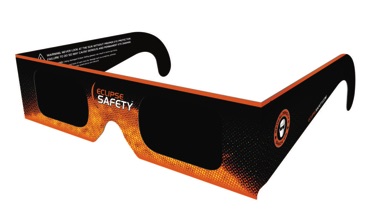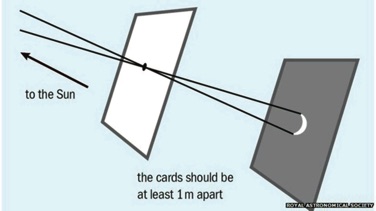The Sun is so bright that looking at it for even a few seconds can result in damage to the eyes or even blindness. As a general rule, NEVER look at the Sun either directly with unaided eyes or through binoculars or a telescope. Since the retina is not sensitive to pain, damage to the eyes can occur without the observer even being aware of it.
Although the Sun’s intensity is reduced during a solar eclipse, it is still dangerous to look directly at the Sun. One safe way to observe the solar eclipse is the through the use of eclipse glasses that possess special solar filters that block out the harmful rays of the Sun. It is important to note that sunglasses, even expensive ones, are NOT appropriate for solar eclipse viewing as they will not sufficiently reduce the harmful rays of the Sun and prevent eye damage from occurring.
One of the safest ways to observe a solar eclipse is through the method of pinhole projection. This method projects an image of the Sun thorough a pinhole on an upper card to a second viewing card behind the first pinhole card. Make sure that your back is to Sun when viewing the projected image on the second card; this reduces any chance that you may inadvertently look at the Sun during this process of pinhole projection. What you have really produced with these two cards is a very simple pinhole camera.
Another way to safely observe the eclipse will be to attend solar eclipse viewing events that many local astronomy clubs and Science centres will be setting up right across North America. These events will provide opportunities for safe viewing of the eclipse.
Observers directly in the path of totality will actually have a small window of opportunity to directly observe the solar eclipse. During the brief period of totality it is safe to look directly at the obscured Sun; the Sun will be as bright as a full Moon during totality. Note that safe viewing is ONLY available for observers directly in the path of totality and ONLY during the brief period that totality actually occurs. The view to the right in the main panel shows how the total eclipse will look like from Casper, Wyoming; totality starts at 17:42:42.5 UT and will last for 2 minutes and 26 seconds. Direct viewing in Casper, Wyoming is only safe during this extremely short time interval.

